Reformation
📜 Luther's Early Life and Spiritual Crisis
Born in Saxony, became a Monk at Wittenberg after a near‑fatal lightning strike in his youth.
Family pressure: father wanted him to be a lawyer; Luther chose the monastic path after the accident.
Personal struggles: suffered from anxiety and a deep fear of sin.
Biblical study: read the entire Bible, which led him to question:
The authority of the Pope
The practice of indulgences
The necessity of good deeds for salvation
“If the lightning had not struck, I might have followed my father’s wishes and become a lawyer.”
Visual aid: The stormy image symbolizes the pivotal lightning incident that redirected Luther’s life.

The dark cloud and lightning illustrate the moment that sparked Luther’s turn toward monasticism and later reform.
⚜ The 95 Theses and the Indulgence Controversy (1517)
John Tetzel, an egregious friar, arrived in Wittenberg to sell indulgences—proceeds funded St. Peter’s Cathedral in Rome.
Popular slogan:
“As soon as a coin in the coffer rings, a soul from purgatory springs.”
Indulgence theology: claimed the Pope’s abundant goodness could pay for sinners.
Luther’s response: wrote the 95 Theses, challenging:
The need for good deeds to obtain salvation.
The scriptural authority of the Pope.
The printing press enabled rapid dissemination of the theses.
Illustration of the moment Luther nailed his theses:
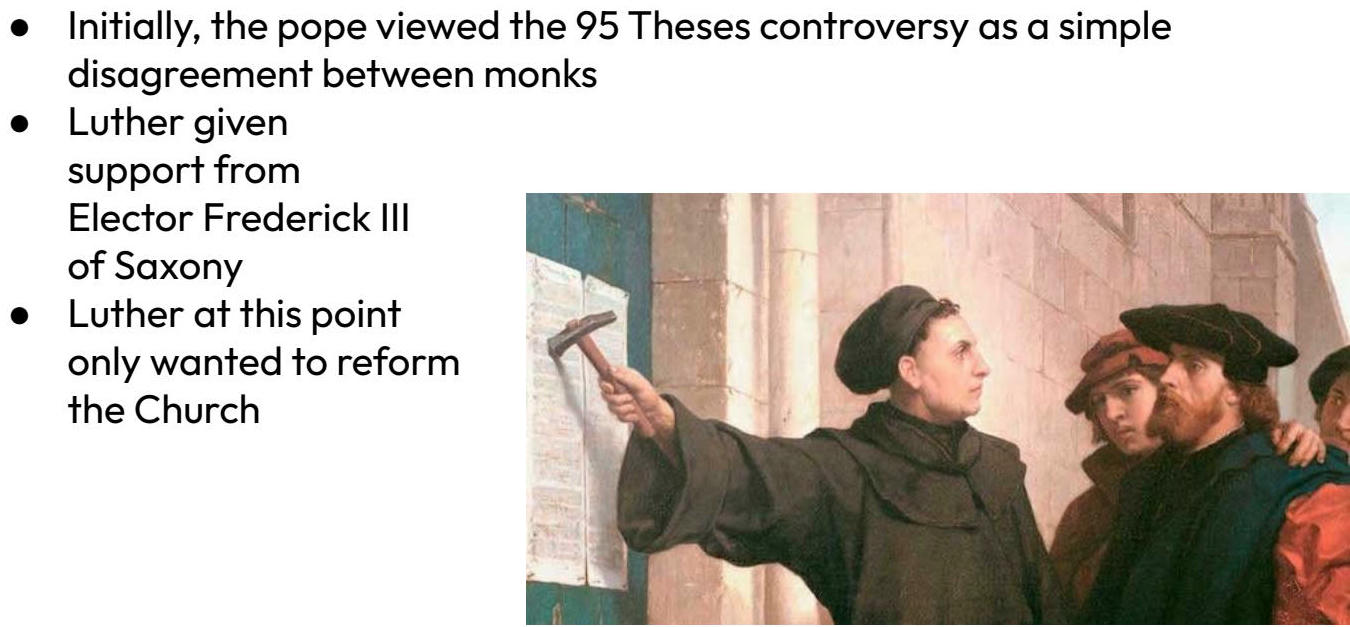
The painting shows Luther’s act of protest, his support from Elector Frederick III, and the Pope’s initial dismissal of the controversy.
🗣 The Leipzig Debate & Excommunication (1520)
Debate with Johann Eck in Leipzig; Luther denied the infallibility of the papacy and condemned the execution of Jan Hus (1415).
Consequences:
Pope Leo X issued a bull of excommunication.
Luther did not intend to split from the Church at this stage.
Event | Year |
|---|---|
Leipzig Debate | 1520 |
Excommunication by Pope Leo X | 1520 |
⚖ The Diet of Worms (1521)
Emperor Charles V (age 21) presided over the trial, seeking to maintain imperial stability.
Luther’s stand:
“I cannot and will not recant anything.”
Outcome: Luther was declared a heretic, outlawed, but allowed to go home because authorities feared popular revolt.
Frederick III later kidnapped Luther to protect him from possible execution.
Depiction of the imperial court:
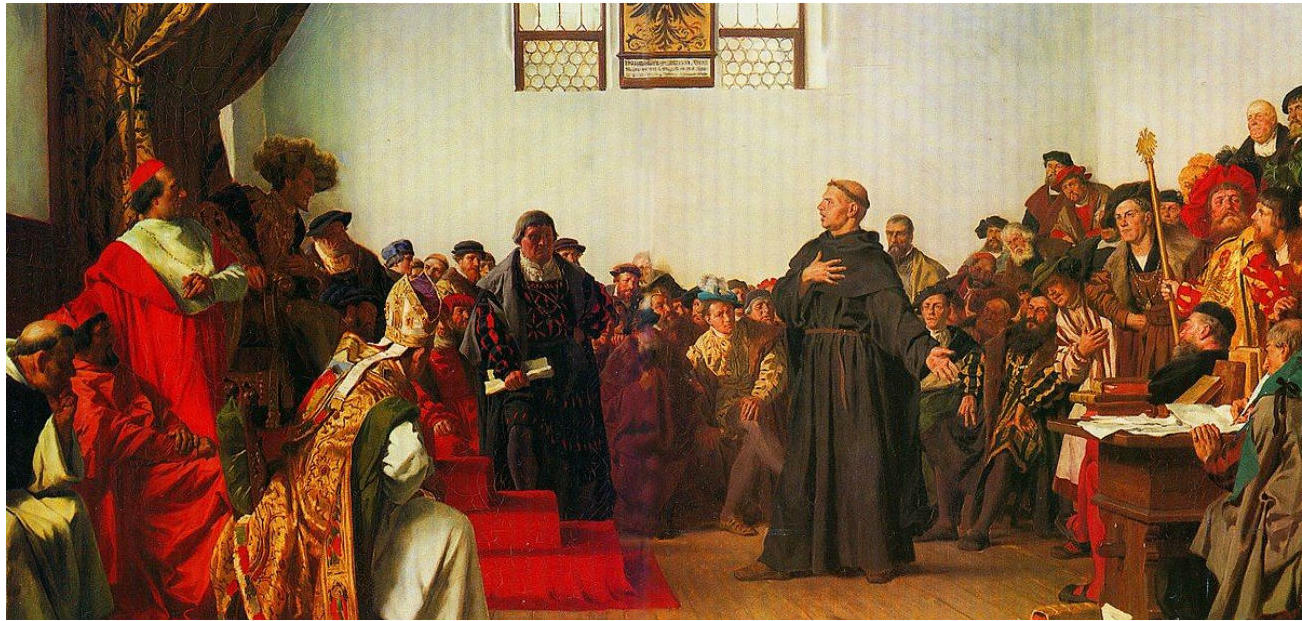
The crowded hall illustrates the tense atmosphere of the Diet, with religious and secular leaders confronting Luther.
📖 The Augsburg Confession (1530)
Core ideas:
Sola fide – salvation by faith alone, a radical shift from Catholic reliance on good deeds.
Universal priesthood: every vocation (including women) can serve God; the Bible is the sole authority.
The Church is a community of believers, not a hierarchy of priests and monks.
Lutheran Belief | Catholic Counterpart |
|---|---|
Salvation by faith alone | Salvation by faith + works |
Bible as sole authority | Tradition & Papal authority |
All vocations equal in merit | Clerical hierarchy privileged |
Priesthood of all believers | Ordained priesthood exclusive |
Symbolic illustration of the Bible’s central role:
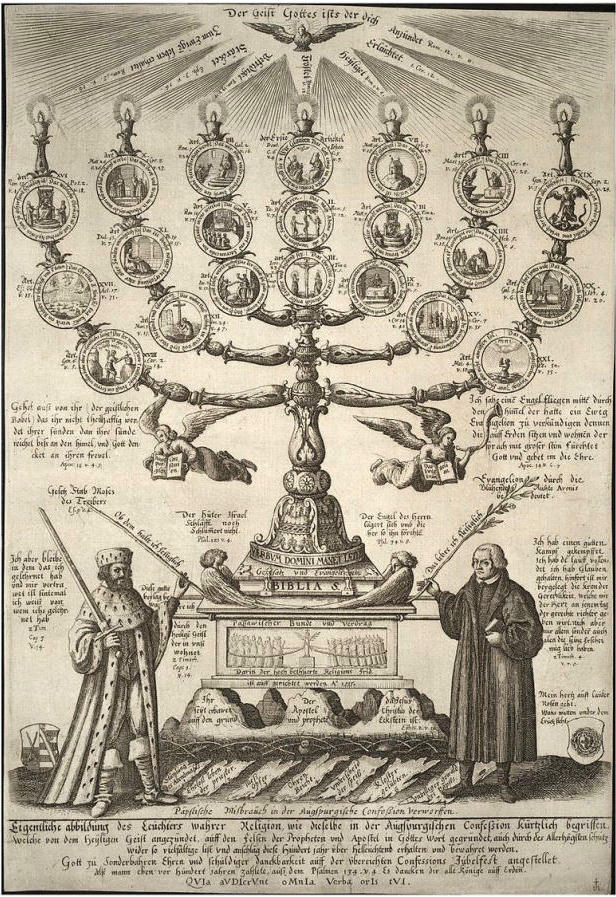
The menorah and the inscription “BIBLIA SACRA” highlight the Reformation’s emphasis on Scripture over ecclesiastical tradition.
🌍 Spread of Lutheranism in the Holy Roman Empire
Geography: Rapidly embraced in northern German states and Scandinavia (Denmark, etc.).
Political motive: Princes sought to shed papal authority and claim church lands.
Humanist influence: Emphasis on individual intellect over clerical mediation.
Imperial response:
Charles V tolerated Lutheranism to prevent civil war and Turkish invasion.
The 1555 Peace of Augsburg forced each state to choose either Lutheranism or Catholicism (the cuius regio, eius religio principle).
Region | Dominant Faith after 1555 |
|---|---|
Northern Germany | Lutheran |
Southern Germany | Catholic |
Portrait of Francis I (contemporary ruler) provides context for the broader European power dynamics.
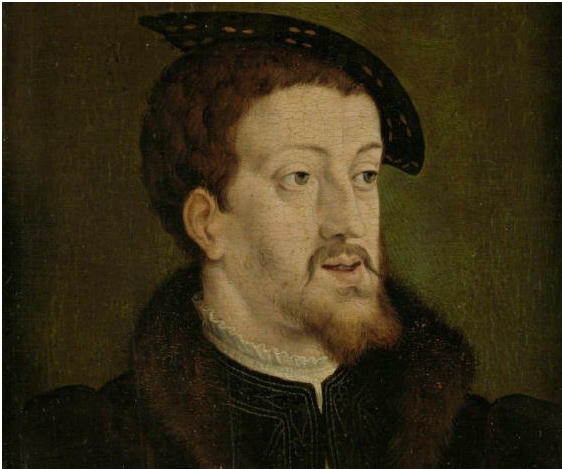
Francis I’s image underscores the political backdrop against which the Reformation unfolded.
🕊 The 1555 Peace of Augsburg
Formalized religious coexistence within the Holy Roman Empire.
Each principality could officially adopt either Lutheranism or Catholicism, but could not mix them.
“All subjects shall follow the confession of their ruler.” (cuius regio, eius religio)
⚔ German Peasants' War (1524‑1525)
“Twelve Articles” demanded an end to German feudal oppression.
Luther’s stance:
Urged obedience to secular authorities.
Called on princes to suppress the revolt.
Result: ≈100,000 deaths at the hands of Catholic and Lutheran forces; the rebellion was ultimately crushed.
“The peasants must submit to their rulers; rebellion is contrary to Christian order.”
Summary: Luther’s dual identity as a conservative political voice and a radical religious reformer shaped the era’s turbulent transformations.## 🌍 Religious Landscape of 16th‑Century Europe
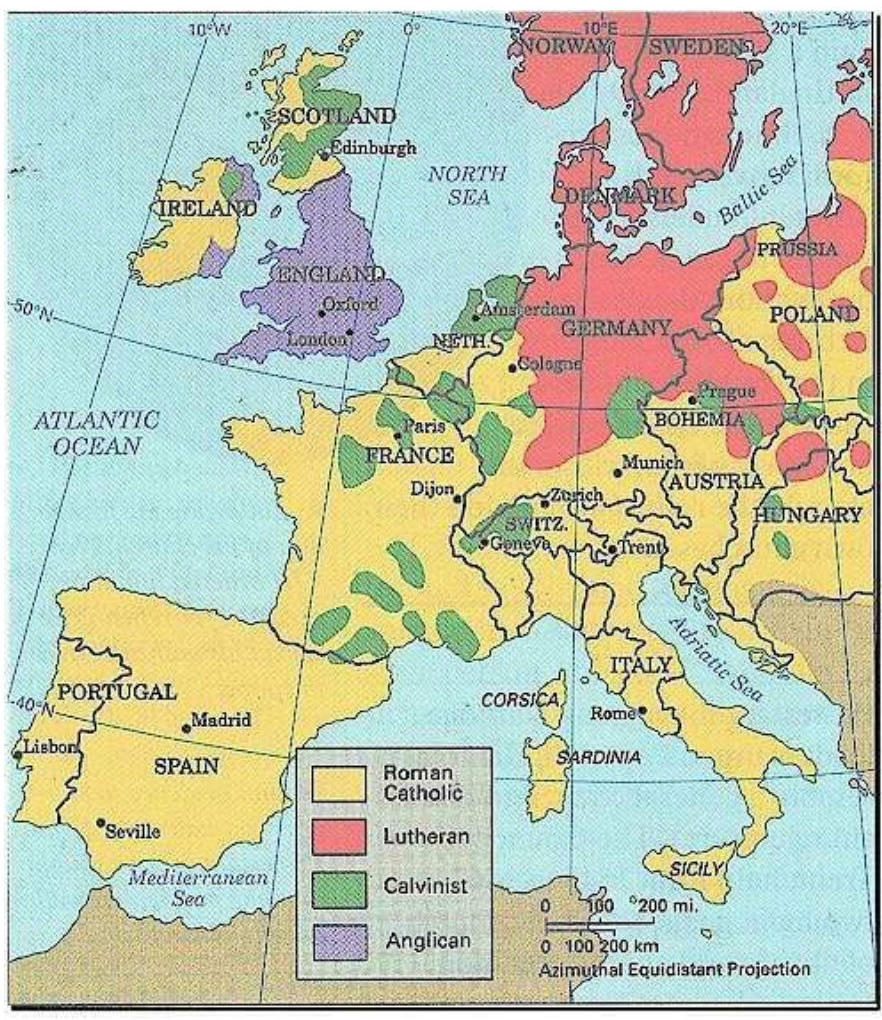
The color‑coded map visualizes how the Protestant Reformation fragmented the continent. Yellow areas remained Roman Catholic, red denotes Lutheran strongholds (Germany, Scandinavia), green marks Calvinist influence (France, the Netherlands, Scotland), and purple indicates the Anglican realm (England). This geographic spread helps explain the political and religious conflicts that followed.
✝ Major Protestant Movements
🕊 Anabaptism
Definition: A radical Protestant sect that advocated adult baptism, a separation of church and state, and faith expressed through good works.
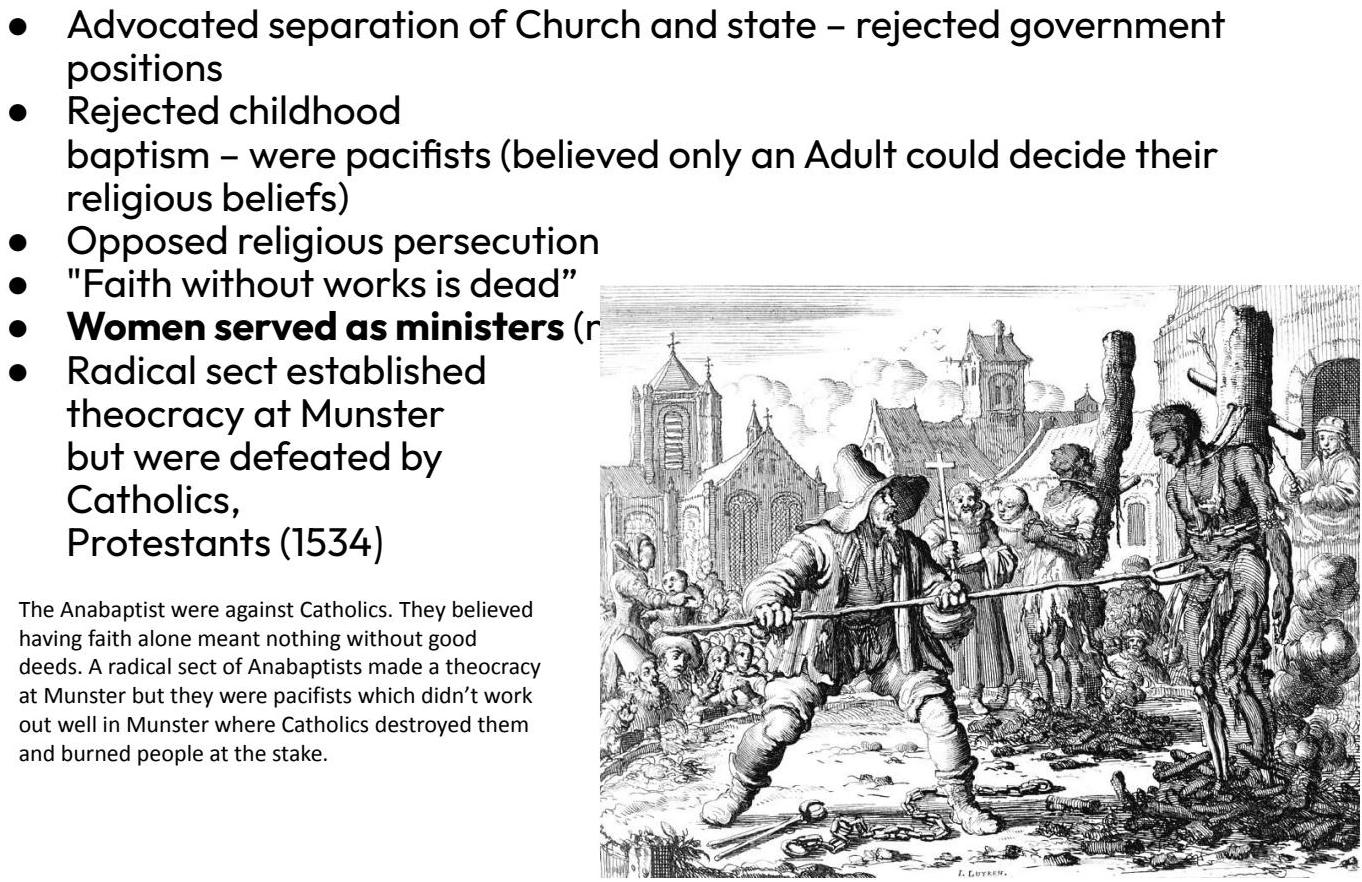
The left‑hand text outlines core beliefs: rejection of infant baptism, opposition to religious persecution, and the presence of women ministers. The right‑hand illustration dramatizes the Munster uprising (1534), when Anabaptists briefly established a theocracy before being defeated by Catholic and Protestant forces.
Key Characteristics
Separation of church & state – politics should not control worship.
Adult (believer) baptism – baptism follows a personal confession of faith.
Pacifism (major branch) vs. militant faction (Munster).
Emphasis on deeds – “faith accompanied by good works.”
📜 Zwinglism
Founder: Ulrich Zwingli (1484‑1531), leader of the Zurich Reformation.
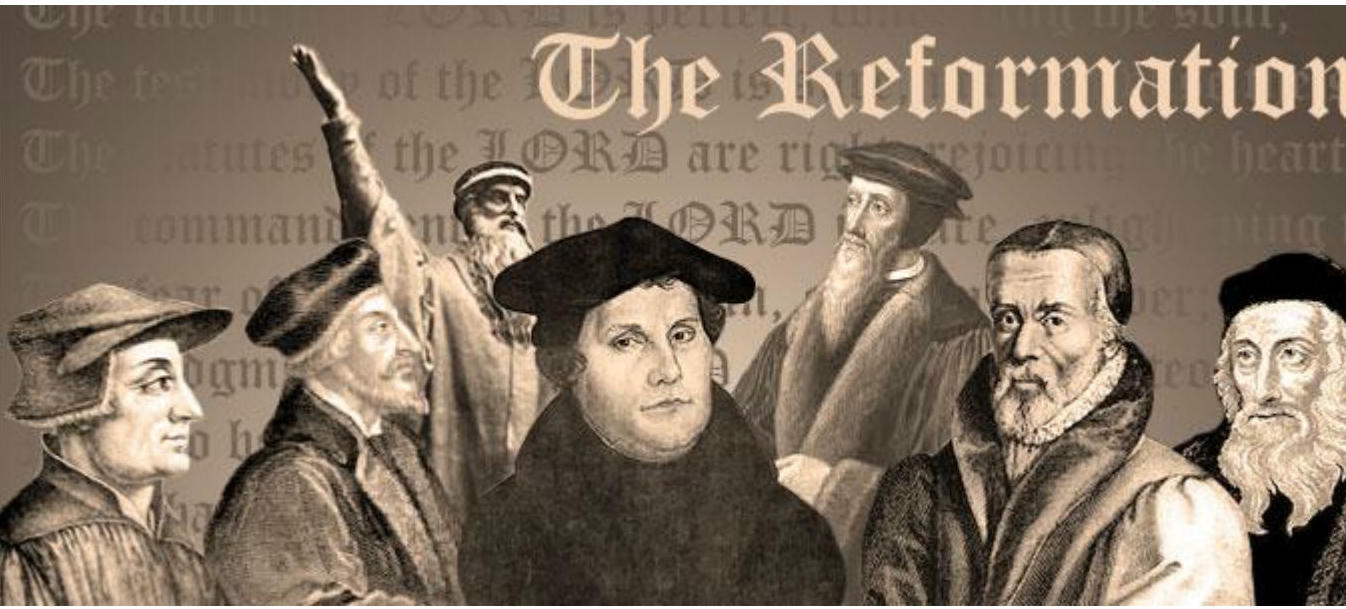
The collage places Zwingli among other reformers, underscoring the plurality of theological positions within the broader Reformation.
Core Beliefs
Bible as sole authority – scripture alone governs faith and practice.
Eucharist: Symbolic (no change in the elements); contrasts with Luther’s consubstantiation and the Catholic transubstantiation.
Theocracy in Zurich – Zwingli helped establish a city‑wide religious reform.
Opposition to Catholic rituals (e.g., pilgrimages, veneration of saints).
Eucharistic Views Comparison
Tradition | View of the Elements | Terminology |
|---|---|---|
Catholic | Bread & wine become the actual body & blood of Christ | Transubstantiation |
Lutheran | Christ’s body & blood are present “in, with, and under” the elements | Consubstantiation |
Zwinglian | Bread & wine are symbols of Christ’s sacrifice | Symbolic memorial |
Calvinist | Spiritual presence of Christ received by faith | Spiritual real presence |
📖 Calvinism
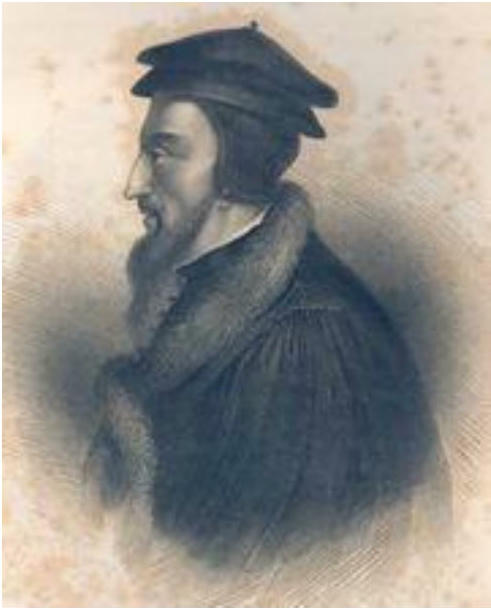
Calvin’s portrait accompanies a brief on his theology, highlighting how his ideas spread from Geneva to the rest of Europe.
Foundational Works
Institutes of the Christian Religion (1536) – systematic presentation of Reformed doctrine.
Key Doctrines
Predestination: God has eternally chosen some for salvation; others are reprobated.
Sovereignty of God – “God is all‑knowing and all‑powerful.”
Theocracy in Geneva (1540): Strict moral code; bans on dancing, card games, etc.
Spread of Calvinism
Region | Notable Followers / Movements |
|---|---|
France | Huguenots (French Calvinists) |
Netherlands | Sparked the Dutch Revolt (1568‑1648) |
Scotland | Adopted by John Knox, forming the Presbyterian Church |
Social Appeal – Calvinism resonated with hard‑working merchants who valued discipline and the notion of being a “chosen” people.
⛪ Anglicanism (Henry VIII)
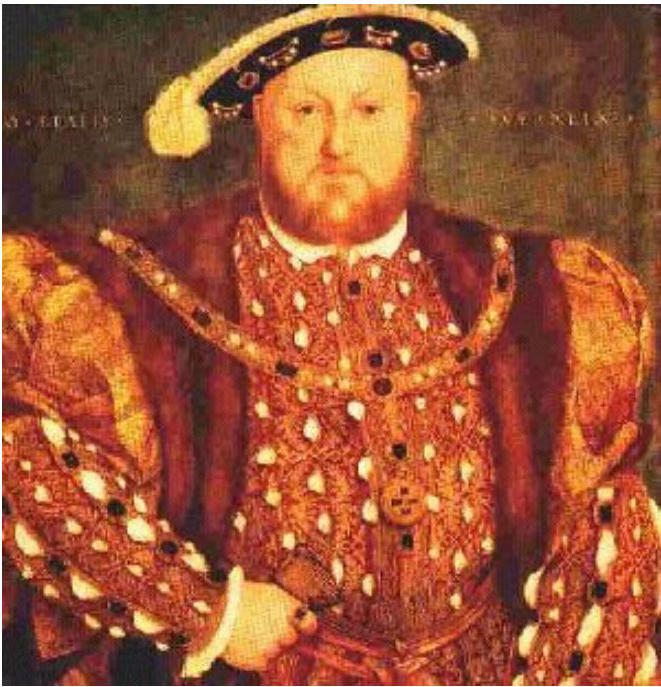
Henry’s portrait underscores his political motive for establishing the Church of England, rather than purely theological concerns.
Key Points
Act of Supremacy (1534): Declared the king the Supreme Head of the Church of England.
“Defender of the Faith” title originally granted by the Pope (before the break).
Retained many Catholic liturgical elements while rejecting papal authority.
👑 Henry VIII and the English Reformation
📅 Chronology of Henry’s Marriages
Wife | Marriage Years | Notable Outcome |
|---|---|---|
Catherine of Aragon | 1509 – 1533 | Annulment led to break with Rome |
Anne Boleyn | 1533 – 1536 | Executed; mother of Elizabeth I |
Jane Seymour | 1536 – 1537 | Died after childbirth |
Anne of Cleves | Jan 1540 – July 1540 | Annulled; political alliance |
Catherine Howard | 1540 – 1542 | Executed for adultery |
Catherine Parr | 1543 – 1547 | Survived Henry, acted as regent |
Quote: “The English Reformation wasn’t really religiously driven; it started from Henry’s desire for an annulment.” – (historical summary)
📚 Intellectual Foundations
John Wycliffe (14th C.) and the Lollards introduced early calls for reform and Bible translation.
William Tyndale (c. 1524) produced the first English Bible translation, influencing later reformers.

Tyndale’s work was deemed heretical; he was burned at the stake in 1536, yet his translations became the basis for the King James Version.
⚖ Legal & Social Changes
Act of Supremacy gave the monarch authority to appoint bishops and control church property.
Dissolution of the Monasteries (1536‑1541) transferred wealth to the Crown and weakened Catholic monastic influence.
👥 Public Reaction
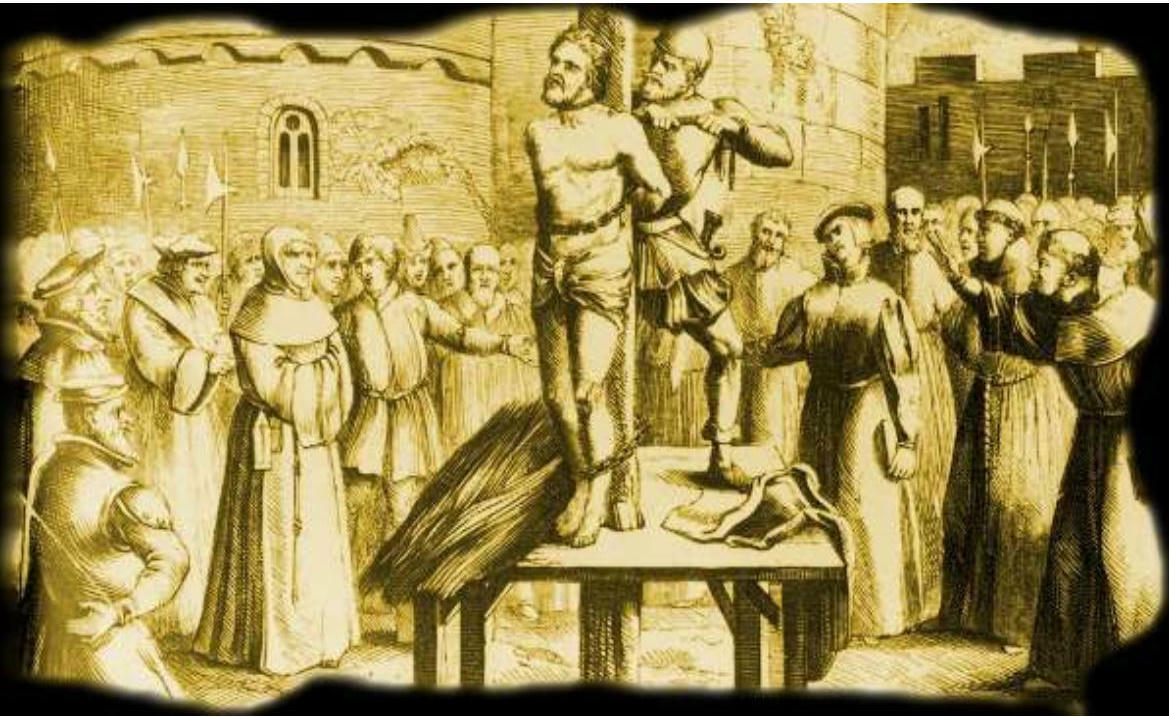
The image captures the public spectacle often used to enforce the new religious order—executions of dissenters served as warnings during the tumultuous break with Rome.
📚 Key Reformers at a Glance
Reformers | Primary Contribution | Associated Movement |
|---|---|---|
Martin Luther | 95 Theses; doctrine of justification by faith | Lutheranism |
Ulrich Zwingli | Emphasis on scripture alone; symbolic Eucharist | Zwinglianism |
John Calvin | Institutes; predestination | Calvinism |
William Tyndale | First English Bible translation | English Reformation |
Thomas Müntzer (not shown) | Radical social‑religious ideas, led German Peasants' War | Anabaptist‑like |
Henry VIII | Established Anglican Church | Anglicanism |
🗂 Comparative Summary of Reformation Themes
Theme | Catholic | Lutheran | Zwinglian | Calvinist | Anglican |
|---|---|---|---|---|---|
Authority | Pope & Tradition | Scripture + Confession | Scripture alone | Scripture alone | Monarch + Scripture |
Eucharist | Transubstantiation | Consubstantiation | Symbolic | Spiritual presence | Retains elements of both |
Baptism | Infant | Infant & believer | Believer | Believer (infant optional) | Infant |
Church‑State | Separate | Separate (in theory) | Separate | Theocratic (Geneva) | Monarch as head |
Key Figure | Pope Leo X | Martin Luther | Ulrich Zwingli | John Calvin | Henry VIII |
These notes integrate the visual resources provided, present the core doctrines, and organize the material for easy reference and combination with other study sections.## 🔱 Henry VIII & the English Reformation
Marriage to Catherine of Aragon (1527) – Henry sought an annulment after only five children survived, Mary being the sole daughter.
Papal refusal – Rome denied the annulment; Charles V (Holy Roman Emperor) protected the Pope after sacking Rome.
Archbishop Thomas Cran Cranmer persuaded Henry to break from Rome, leading to the formation of the Church of England (1533).
Annulment: A declaration that a marriage was never valid under canon law; unlike divorce, it asserts the marriage “never should have happened.”
Anne Boleyn became Henry’s second wife (1533). After failing to produce a male heir, she faced false charges (adultery, incest, treason) and was executed.
Act of Supremacy (1534) – Declared the King as the Supreme Head of the Church of England.
Act of Succession (1534) – Required an oath of loyalty acknowledging the king’s religious authority.
📜 Key Legislative Acts (1534)
Act | Main Provision | Immediate Effect |
|---|---|---|
Act of Supremacy | King as head of the Church | Ended papal jurisdiction in England |
Act of Succession | Oath of loyalty to the king’s religious authority | Secured political support for the new church |
Dissolution of Monasteries (later) | Confiscation of Catholic lands & monasteries | Revenue doubled, strengthening the military and enriching the nobility |
⚔ Pilgrimage of Grace (1536)
A massive Northern rebellion protesting Henry’s religious reforms and the dissolution of monasteries.
Leaders included Sir Robert Constable, Sir Thomas Percy, and Robert Aske.
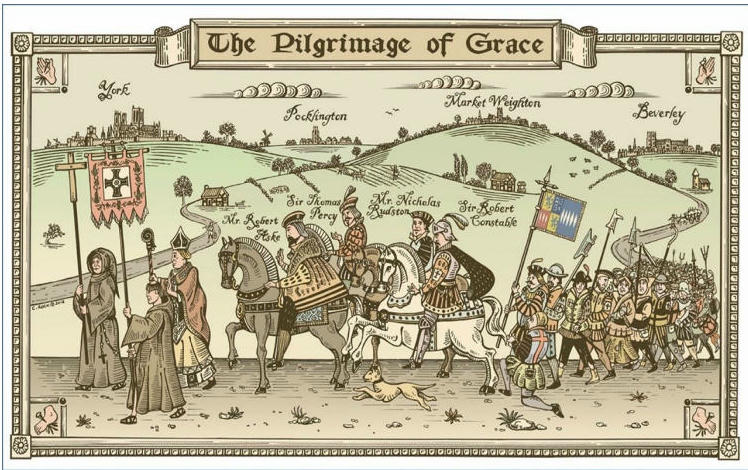
The illustration visualizes the scale of the uprising, highlighting the key figures and the geographic spread across York, Selkington, Market Weighton, and Beverly.
Outcome: Rebellion crushed; ≈200 rebels executed; demonstrated the limits of Protestant reform resistance.
👑 Edward VI & the Short‑Lived Protestant Push (1547‑1553)
Edward VI (son of Jane Seymour and Henry VIII) ascended the throne at nine years old; a council of Protestant advisers governed as regents.
Thomas Cranmer implemented further Protestant changes:
Clergy allowed to marry.
Icons removed from churches.
Doctrine of salvation by faith alone.
Two sacraments retained: Baptism and Communion.
The Book of Common Prayer standardized English worship.
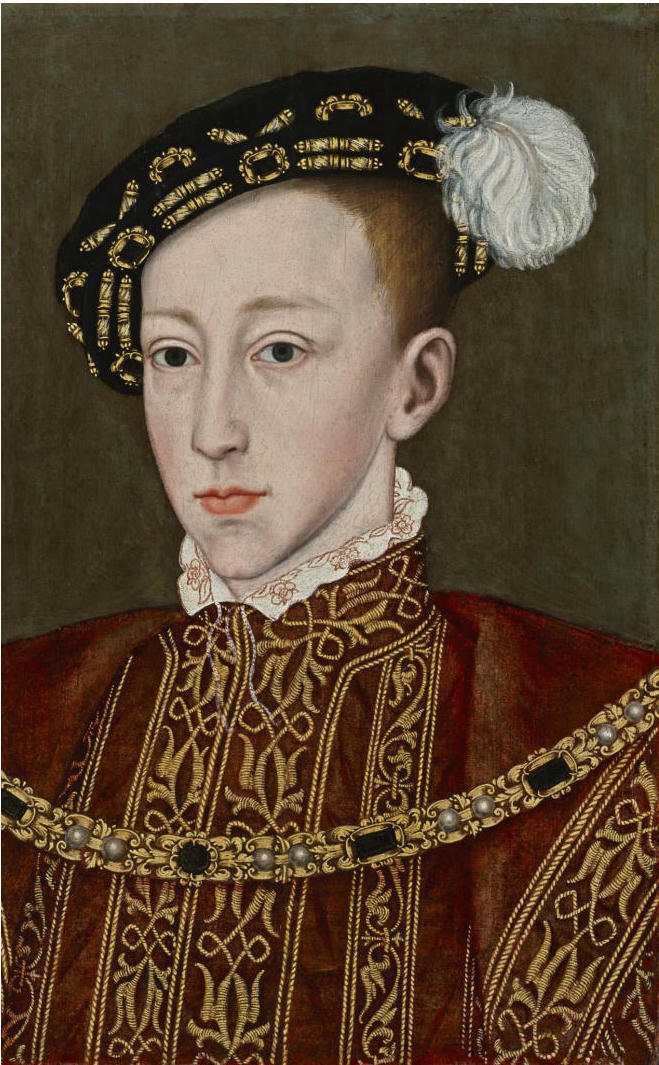
This portrait underscores Edward’s youth and the regal continuity despite the religious upheavals.
👑 Mary I “Bloody Mary” (1553‑1558)
Restored Catholicism after Edward’s death; married Philip II of Spain (1554).
Reversed many of Henry’s and Edward’s statutes; ≈300 clergy and officials executed for refusing to reconvert, including Archbishop Cranmer.
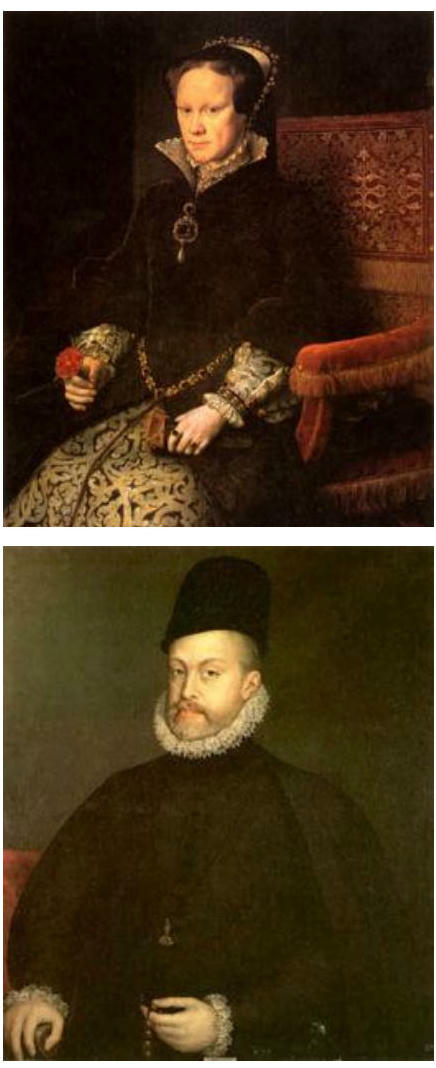
The stark portrait reflects Mary’s austere policies and the atmosphere of persecution during her rule.
👑 Elizabeth I & the Elizabethan Settlement (1558‑1603)
Elizabeth I, daughter of Henry VIII and Anne Boleyn, pursued a moderate Protestant path, known as the Elizabethan Settlement.
Key elements:
Rituals resembling Catholic practice were permitted.
Clergy prohibited from marrying; no marriage for clergy at all.
Services conducted in English.
Mandatory attendance at church under penalty of a fine.
Adopted a politique stance—seeking religious middle ground to maintain national peace.
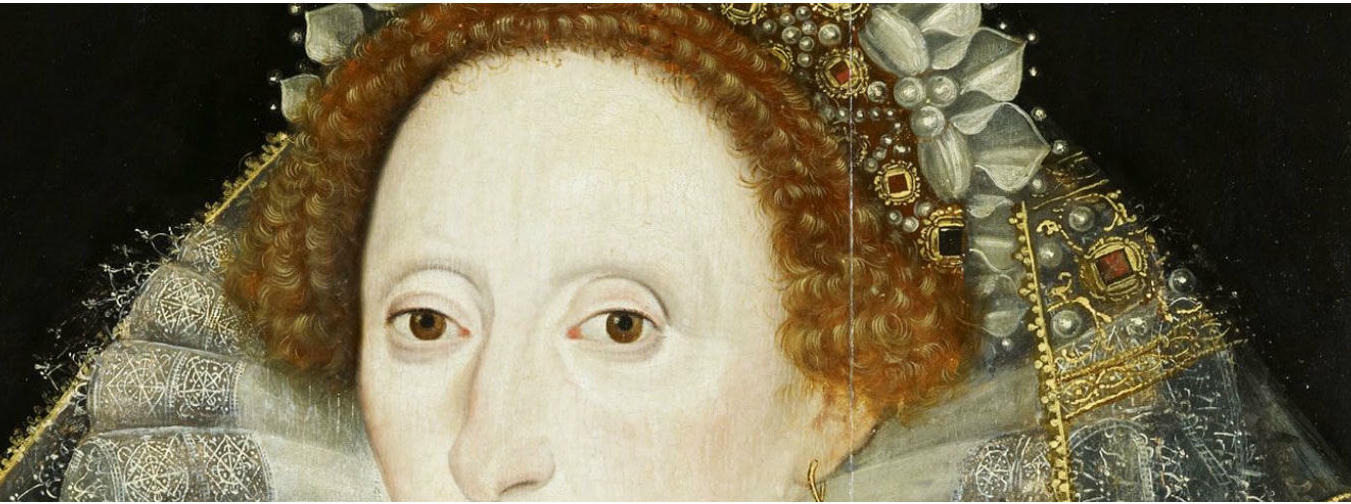
Elizabeth’s regal bearing and fashion (notably the ruff) illustrate the era’s blend of authority and artistic patronage.
🎀 Fashion Note: The “Ruff”
During the Elizabethan era, large collars (ruffs) became a popular fashion statement across northern Europe.
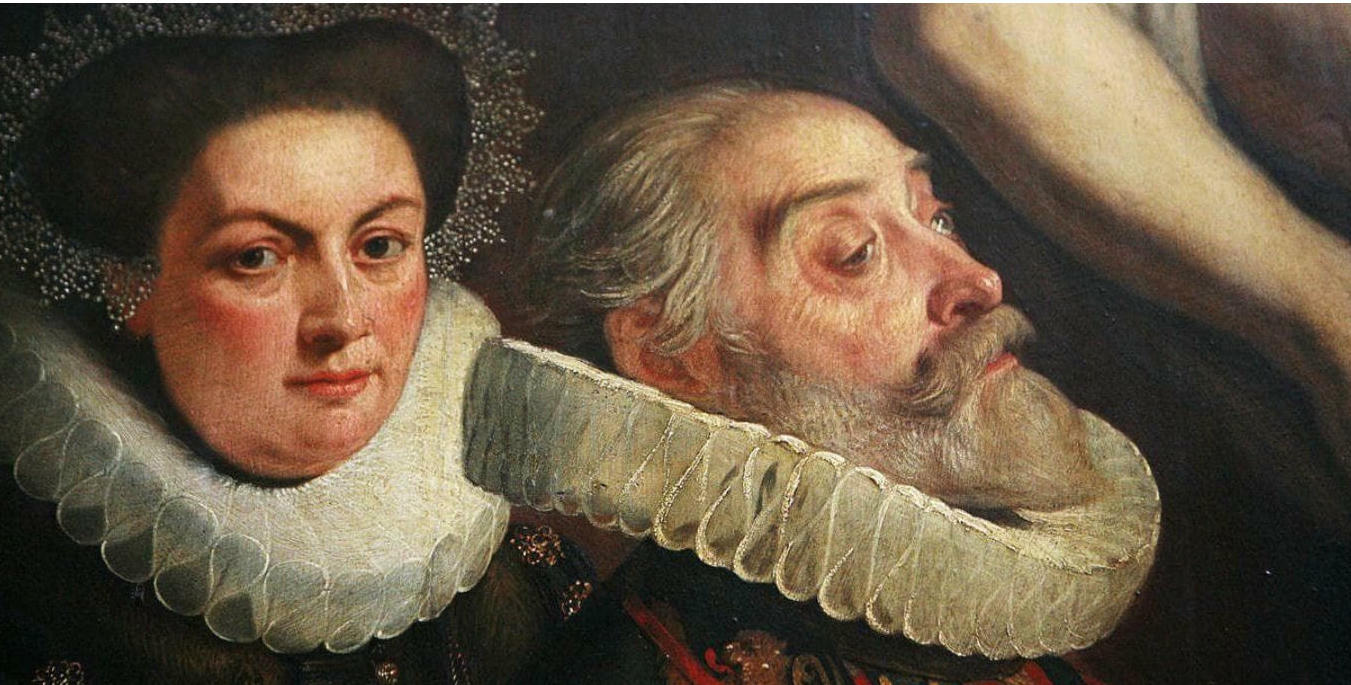
This detail highlights the opulent style that signified wealth and courtly identity.
📚 Counter‑Reformation: Council of Trent & the Index of Prohibited Books (1545‑1563)
Council of Trent (1545‑1563) was the Catholic Church’s systematic response to Protestantism.
Limited simony (sale of church offices).
Established seminaries for clergy education.
Rejected Protestant doctrines; reaffirmed seven sacraments and the priest’s role in salvation.
Promoted Baroque art to inspire devotion.
Index of Prohibited Books (1559) listed works deemed heretical, including writings of Martin Luther and John Calvin.
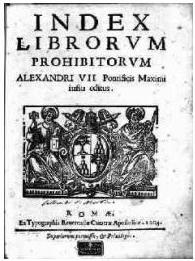
The ornate cover reflects the seriousness with which the Church guarded doctrinal purity.
🎨 Baroque Art
Baroque style: Emphasized emotion, movement, and dramatic lighting to convey religious fervor.
Served as a visual tool of the Counter‑Reformation, reinforcing Catholic teachings through compelling imagery.
📅 Chronology of Key Events (1509‑1603)
Year | Monarch / Event | Religious Impact |
|---|---|---|
1509 | Henry VIII becomes king | Begins Tudor dynasty |
1527 | Henry seeks annulment | Sparks break with Rome |
1533 | Marriage to Anne Boleyn | Formalizes break |
1534 | Act of Supremacy & Succession | Establishes Church of England |
1536 | Pilgrimage of Grace | Largest Northern rebellion |
1547 | Edward VI ascends | Deepens Protestant reforms |
1553 | Mary I ascends | Re‑imposes Catholicism |
1558 | Elizabeth I ascends | Enacts Elizabethan Settlement |
1559 | Index of Prohibited Books | Catholic Counter‑Reformation |
1563 | Council of Trent concludes | Reinforces Catholic doctrine |
---## 📜 Pope Paul III & the Counter‑Reformation
Pope Paul III (reigned 1534‑1549) recognized the massive secessions from the Catholic Church and concluded that reforms were essential.
Key action: Initiated the Council of Trent (1545‑1563) to address doctrinal issues and curb Protestant expansion.
“maybe we need to change some stuff” – Pope Paul III’s pragmatic acknowledgment of the Church’s crisis.
✨ Ignatius Loyola & the Society of Jesus (Jesuits)
Figure | Lifespan | Major Contribution | Date Founded |
|---|---|---|---|
Ignatius Loyola | 1491‑1556 | Authored the “Spiritual Exercises”; emphasized obedience to Church authority | 1540 (Jesuit Order) |
Jesuits | — | Missionary work worldwide; founded schools; acted as “soldiers of the Pope” | — |
Background: Former Spanish soldier wounded in battle → turned to religious life.
Mission: Spread Catholicism globally, counter Protestant influence, and establish educational institutions across Europe and the New World.
🎨 Art of the Counter‑Reformation
Caravaggio – Judith Beheading Holofernes (c. 1598‑1599)
Style: Dramatic chiaroscuro; vivid realism that emphasizes moral triumph over tyranny.
Theme: Biblical heroine Judith vanquishes the Assyrian general Holofernes, symbolizing the Church’s victory over heresy.
Bernini – The Ecstasy of Saint Theresa (1647) – Santa Maria della Vittoria, Rome
Medium: White marble sculpture in an elaborate altar setting.
Narrative: Saint Theresa’s mystical vision, captured in a moment of divine rapture.
“EI will believe that the white object I see is black if that should be the desire of the hierarchical church” – a stark reminder that artistic interpretation can be shaped by ecclesiastical power.
👩👧👦 The Protestant Reformation & Family Life
Aspect | Protestant View (e.g., Calvin, Luther) | Catholic Counter‑Reformation Response |
|---|---|---|
Role of Women | Calvin: Subjugation to preserve moral order; limited public roles. <br> Luther: More permissive view of sexuality but still confined to domestic sphere. | Promotion of female religious orders (Ursulines, Carmelite reforms) to provide education and spiritual leadership. |
Household Centrality | Family becomes the primary site of religious practice; reduced clerical mediation. | Emphasis on parish life and Catholic schooling to keep families within the Church. |
Legal & Political Rights | Decline in women’s political, educational, legal privileges. | Catholic orders educate women and advocate for their spiritual agency (e.g., Ursulines). |
Interaction with Clergy | Fewer direct contacts; lay‑driven worship. | Increased clerical oversight, but also new avenues for women via convents. |
Key outcome: The Reformation shifted the private sphere (home) into a central religious arena, while the Catholic response sought to reassert communal authority through education and reformist female orders.
🙏 Catholic Women Reformers
Name | Lifespan | Founder/Contribution | Core Emphasis |
|---|---|---|---|
Angela Merici | 1474‑1540 | Founded the Ursuline Order of nuns; pioneered female education. | Educating women and combating heresy. |
Teresa de Ávila | 1515‑1582 | Reformed Spanish convents; authored mystical writings. | Personal relationship with God and poverty. |
Impact: Both women expanded opportunities for Catholic women, counterbalancing the Protestant restriction of female roles.